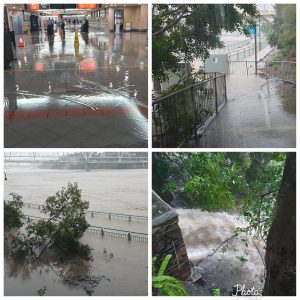
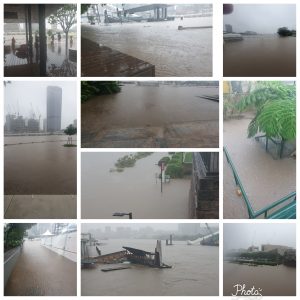
The weather system that swept along the Australian east coast in late February and early March has caused enormous damage to the many villages and towns in the coastal region throughout Queensland and NSW and, of course, there are a lot of terrible stories to tell.
El Nino created a lot of extra moisture in the Pacific Ocean. As soon as it made landfall the high temperature caused this to develop in rain bombs which were dumped over a two week period above the Sunshine Coast, Brisbane, Northern NSW, Sydney and surrounds.
It started on the 23rd of February on the Sunshine Coast.
My report is about Brisbane which has also been hugely affected and because it is a big city the damage here is enormous. The storm here lasted three days: 25, 26, 27 February. Over this three day, Brisbane received 678.8 mm of rain, beating the previous three day record of 1974 with 600.4 mm. More than 23,000 homes and businesses suffered water damage. It grounded the ferry system and damaged numerous roads, bike and pathways as well as parks. In a report delivered in May, by former governor and supreme court chief justice Paul de Jersey, it was stated that this was Brisbane’s biggest-ever three-day rain event with more than 20,000 properties across 177 suburbs impacted by a combination of river, creek and overland flow flooding.
From here it moved to NSW with a devastating effect on Lismore and Ballina. A various of storms kept ravaging along the coast during the rest of the week and the following weekend, and in particularly hit the Newcastle, Hunter and Sydney area. In all the storms took the lives of 22 people across Queensland and NSW.
The history of Brisbane Floods
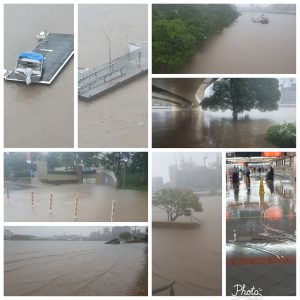
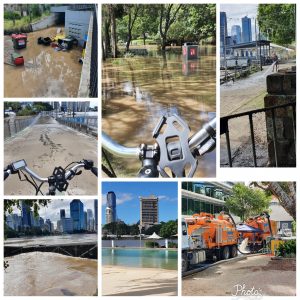
When the British soldiers built a penal colony here in 1825, they had a good idea of the high ground, in what is now the center of Brisbane. During this period (until 1840) the 2000 convicts and the soldiers were able to keep their feet dry. It was not the intention of the British when the penal colony was abolished to grow a city there. It was a situation of pioneers who arrived and set up their tent somewhere and then turned it into a hut. Queensland did not exist at that time and was governed from Sydney and that was certainly far away at that time.
Between 1840 and 1860 it was mainly sprawl and the surveyors who mapped the city and its surroundings had in fact only one commission to Views from Victoria Bridge create as many building blocks as possible because that was the only way
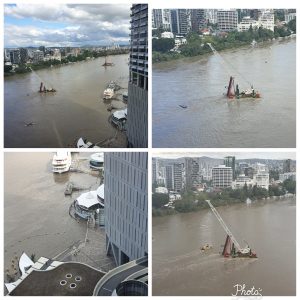
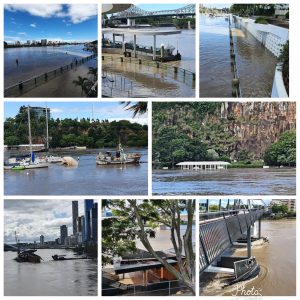
for Queensland, which became independent in 1859, to get money in. It did not take into account the floodplains along the Brisbane River and the dozens of rivers and streams that crisscross what is now Brisbane. On the contrary, those were the places that made the most money. During the last 200 years there is a flood somewhere about once every two years.
The first major storm surge soon came in 1857 and then in 1863 and a year later in 1864 and except for the old part of the penal settlement everything was under water. The city was then small no more than 5,000 inhabitants and there were few ‘real’ houses, the slums just drifted away with the water, and were rebuilt. A lot of misery but not too much damage.
The flood of 1872 flooded the entire city again. The flood of 1893 was one of the largest of all and knocked away the newly built first bridge over the river.
This will not be the last flood
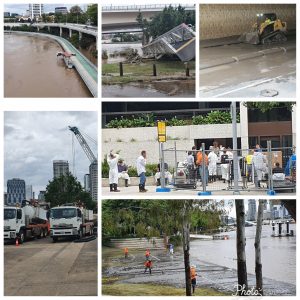

With a rapidly growing population and little regulation, the damage got bigger and bigger. When another flood occurred in 1974, the city had more than 1 million inhabitants and that caused new dams to be built to collect the water and then slowly flow through the river to Moreton Bay. But the flood
of 2011 made it clear that this did not help very much, and the flood of 2022 confirms that once again.
In the Netherlands, they have had a new water strategy for 20 years: Give the river space. Habitation has been removed from old floodplains and new floodplains have been added to it. This on top of the dikes that the Netherlands has built since the 13th century.
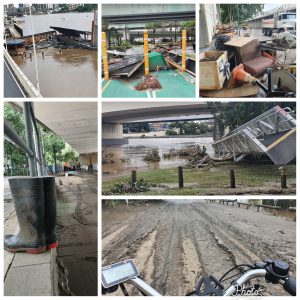
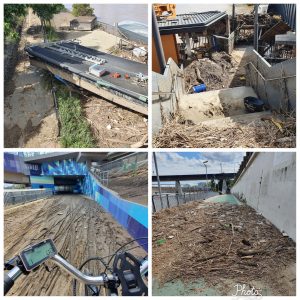
While that might be the best solution, it’s not realistic to imagine something like that for Australia, but then what? You really can no longer speak of 1:100 years or 1:50 year major floods. In general, it is the same areas that are flooded again, how long can you last to go through such floods again and again?
Every storm is different and the one from 2022 was a rain bomb, similar to the storm that hit the corner of Germany, Belgium and the Netherlands last year, the prediction with increased climate change is that it is precisely these types of storms that will occur more and more.
We moved to Brisbane two years ago, before that we lived in Bucketty in the Hunter Valley. During the 30 years that we lived there we went through 5 bushfires, but we always had the idea that with the right materials we could do something about this and we always succeeded. You don’t have that option if you live in those areas where flooding happens time and time again.
It is now on to the next flood in 5, 10 or 20 years, one thing is certain it is inevitable and thousands of houses will be flooded again.
The report from Mr de Jersey recommends an expansion of Council’s Flood Resilient Homes Program and introduction of a voluntary home purchase scheme in collaboration with the State and Federal governments.
Walking and bike reports from the floods
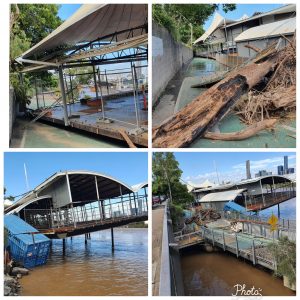
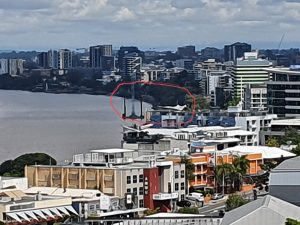
During the storm I went on foot to see for myself what happened to the Brisbane River and it is unimaginable to see what kind of power that water has. One pontoon after the other with or without a boat on it floated by. Some hit the pillars of the bridge and stuck to it. Pavilions passed, garbage bins and so on.The day after the storm, typical Queensland weather with plenty of sun, I went out on my bike. Many cycle paths run along the river and they were all under water. What struck me during the bike ride was the mud that stinks and sticks enormously. I was reminded of the thousands of people who are now dealing with that. I can’t imagine the disaster if your house is full of that mud.
Massive clean up
In the following days I checked the various bike ways. The Bicentenary Bike Way was a week later still one big mess and it will be quite some time before the remnants of the cafe have been removed. It also looks like that all of the ferry terminals bu ult after the 2011 flood have been damaged again, it might require a total rethink of the construction of these platforms.
In the clean up more than 800 council workers and eternal personnel as well as the Mud Army, the Australian Defence Force, the US Navy and people from surrounding Councils were involved. In all over 1000 council vehicles were deployed during. More than 17,000 potholes were were repaired and 95,000 tonnes of flood rubbish was removed.
By mid April sixty vessels were salvaged as well as 40 pontoons, 60 navigation aids and a sunken CityCat. This is some of what made up the 6700-tonne mountain of trash and debris fished from the Brisbane River and Moreton Bay – and as far away as Fraser Island. By that time also the Drift Cafe had been removed and the walk and bike way was reopened again. Several ferry terminals were still out of action in June.
The total damage in Queensland is estimated at $2.3 billion, NSW is estimated to also reach the $2 billion. In Brisbane will be a 5% increase in council rates to cover the massive cists of the floods. At the moment the Bureau of Bureau of Meteorology also predict that 2023 will be an El Nino year.
Paul Budde